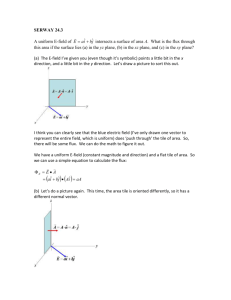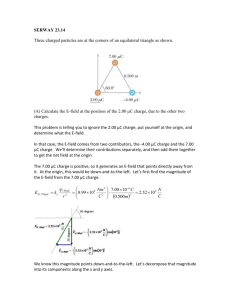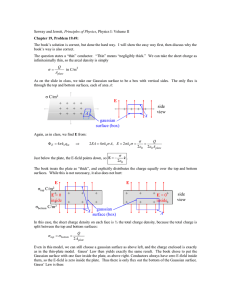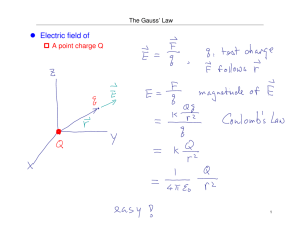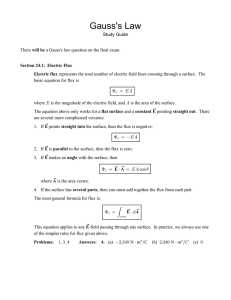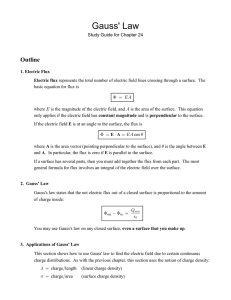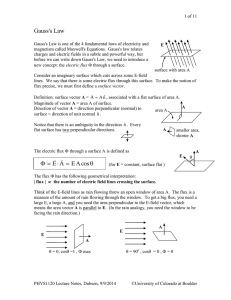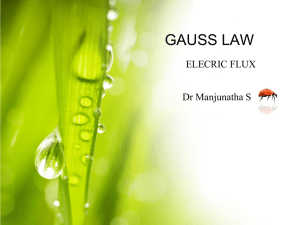19.7: Motion of Charged Particles in a Uniform E-Field
advertisement
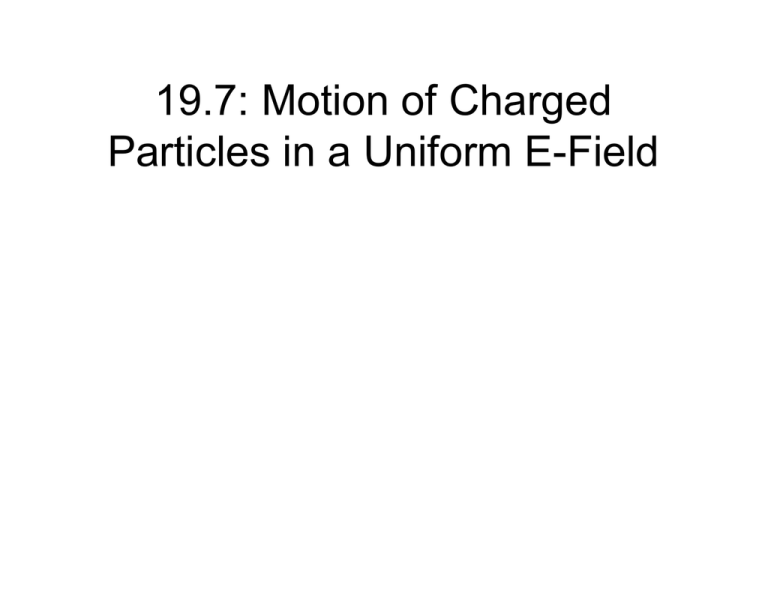
19.7: Motion of Charged Particles in a Uniform E-Field E-field exerts force on a charge Consider an array of + charges and an array of – charges: + – – E + + + – – – +q + + – – + + + + -q + E + + + + F= qE a = qE/m – – – – – – – Cathode Ray Tube E e– F Cathode (–) Anode (+) Accelerating electrons in a constant E-field A single electron is accelerated from rest in a constant electric field of 1000 N/C through a distance of 3 cm. Find the electric force on the electron, and calculate its final velocity (me = 9.1x10-31 kg) E F = qE = mea F = qE = (1.6x10–19 C)(1000N/C) = 1.6x10–16 N Electrophoresis Separation of DNA segments (q ~ –1000 e due to O–’s in phosphate backbone of DNA chain) in an E-field ~ 1000 N/C. Moves through pores in gel towards anode; smaller segments travel further Source: http://dnalc.org http://web.mit.edu/7.02/virtual_lab/RDM/ RDM1virtuallab.html Vinit of charge perp. to E-field vx = vinit = constant vy = ayt = -eEt/me xf = vinitt yf = 1/2 ayt2 = -(1/2)eEt2/me Example 19.7 Application: Ink-jet printers Tiny drop of ink is shot through charging unit, where a negative charge (typ. ~ –1000e) is applied. An E-field is then applied to deflect the drop through the proper angle. 19.8 −19.10 Electric Flux & Gauss’ Law OVERVIEW: Gauss’ Law: relates electric fields and the charges from which they emanate Technique for calculating electric field for a given distribution of charge Relates the total amount of charge to the “electric flux” passing through a closed surface surrounding the charge(s). Electric Flux ΦE Consider a uniform Efield and an area A ⊥ to E-field lines: ΦE = E A If E-field lines make angle θ to normal of plane: ΦE = E A cosθ ΦE • In the more general case, look at a small area element . • In general, this becomes Electric Flux ΦE Through a Cube Uniform E-field parallel to xaxis: What’s the net elec. flux ΦE through the cube? Electric Flux ΦE Through a Cube Uniform E-field parallel to xaxis: What’s the net elec. flux ΦE through the cube? Normal vector points outward for a closed surface Electric Flux ΦE Through a Cube Surface1: E antiparallel to A ΦE = E A cos(180°) = −EL2 Surface 2: E || A ΦE = E A cos(0°) = +EL2 Top & Bottom: E ⊥ A ΦE = E A cos(90°) = 0 Each side: ΦE = E A cos(90°) = 0 Net ΦE = 0+0+0+0+ EL2 - EL2 = 0 The net electric flux through any closed surface will be zero if there is no charge enclosed inside! Gauss’ Law ΦE = Qencl / ε0 ΦE through any closed surface is equal to the net charge enclosed, Qencl, div. by ε0 Gauss’ Law ΦE does not depend on radius of sphere: just the charge enclosed (1/r2 dependence of E cancelled by r2 dependence of A) Gauss’ Law: describes how charges create electric fields Gaussian surfaces: not a real surface -- does not have to coincide with the surface of a physical object Gauss’ Law Eqn 19.22: more generalized form of Gauss’ Law In practice, Gaussian surfaces || or⊥ to E will greatly simplify calculations. Sample Gaussian surfaces Hint: Choose surfaces such that E is ⊥ or || to surface! Gauss’ Law: A sheet of charge Define σ = charge per unit area Quiz #1: Tues. Oct 5 45 mins long, multiple choice. ~8-10 questions Arrive promptly; we start exactly at 09:30! You bring scantrons (X-101864-PAR only!), #2 pencils, erasers, current student ID, scientific calculator, ‘3x5’ index card: you supply all the equations, we supply constants. No cell phones, iPhones, or any other notes allowed. Quiz will cover chapter 19, from section 19.1 up through 19.10 (including examples 19.9 & 19.12, but not examples 19.10 & 19.11) Quiz #1: Tues. Oct 5 Quiz #1: Tues. Oct 5 Really, arrive early -- we need to distribute exam code forms before the quiz can start. Reminder: I have office hours today & Monday at 11:30. Grigor has office hours today & Monday at 2:00 Discussion/problem session, Monday evening at 6:00 Physics Tutorial Center, 3-8 pm tonight, Sun and Mon.

